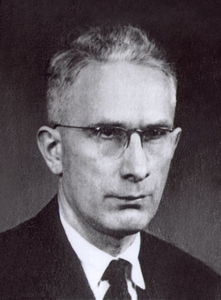Johann Wempe

Prof. Johann Wempe, former institute director of the AOP.
Credit: AIP archiveJohann Wempe was born in Bremen on New Year's Eve 1906 and originally wanted to become a school teacher. Bremen’s harbour was full of ships that required astronomical knowledge to aid in navigation and this apparently attracted Wempe to astronomy. In fact, during his initial school years he participated in evening classes of extramural studies, and also used the old instruments of the famous Bremen doctor and astronomer W. Olbers.
After seven years of studying math, physics, and astronomy in Göttingen, Wempe received his PhD from Göttingen in 1932, with a dissertation on "contributions to photographic spectral photometry" while working for Prof. Kienle. In 1936, he became a scientific assistant at Landessternwarte Heidelberg, where he worked on eclipsing binaries and asteroids, one of which is named after him.
Because of the political climate in Heidelberg, in 1938 Wempe decided to move to Jena to join H. Siedentopf. He was frail and not very healthy, so he did not have to go to the front during the Second World War. Instead, he worked on the "wavelength dependence of atmospheric extinction," the topic of his 1944 Habilitation thesis, written in Jena (published in Astr. Nachrichten 275, 1, 1947). He moved to Potsdam the same year, working with his former PhD advisor Kienle, who had become director of the Astrophysical Observatory Potsdam at its Telegrafenberg site. Their joint goal was the quick reconstruction of the observatory (mainly repairing the instruments that had been damaged during the war). He was appointed as "Observer" in 1946, and as "Lecturer" in 1947. In those days, Wempe was also the head of the workers' union, perhaps a precursor to the requests made in his will that money he left should be used to "improve the living conditions of the people in the observatory.”
After the war ended, he became a professor at Humboldt University in Berlin in 1948, and in 1958 he received the chair that he held till his retirement in 1971. He was the editor of the Astronomische Nachrichten journal for 22 years and, after his retirement, became interested in the history of astronomy in Potsdam.
Two years after Prof. Grotrian's death (1954), Wempe became the director of the Astrophysical Observatory Potsdam (AOP). At the same time he was also a part-time director of the Babelsberg Sternwarte. He likened his position to that of the "conductor of an orchestra.” Under his directorship, in 1967 the AOP was united with the Sonneberg Observatory to become the "institute for stellar physics.” In 1969, when the Zentralinstitut for Astrophysics was founded, Wempe became the director of one of the scientific branches. He also played a key role in the concept and realization of the 2m Schmidt telescope mirror at Tautenburg, which was installed in 1960. Wempe developed the idea and usage of the objective prism, displaying his understanding of not only classical astronomy (and celestial mechanics etc.) but also spectroscopy. Scientifically, he is probably most renowned for his work on the "absolute calibration of the intensity distribution of an AO star," which was published in 1940 (Kienle et al.).
Wempe did not publish much after becoming director of the AOP. Still, he always worked long hours and was mindful towards the wellbeing of employees of the observatory. He also saw to it that there was an AOP Christmas party every year. Throughout his years as director, his major goal was the modernisation of the AOP’s instrumental equipment in order to provide the younger astronomers with the best possible working conditions available in astrophysics.
Wempe was never married and his sister oversaw his household. He enjoyed gardening (especially sun-flowers) and music (he was a member of the Händel society) and was known as a very modest man. He is said to have been very critical and demanding both as a teacher and as an editor but was also known to have had a good sense of humour, despite his Nordic reserve.
Wempe died on May 29, 1980 at the age of 73.
(Compiled and translated from various obituaries by Hans Zinnecker)